Saikawa Buntai, Genshin Seian, Akihito Obama, Vlastislav Matoušek, Dietmar Ippu Herriger
The central figures of the concert are Sakai Genshin and Saikawa Buntai, two important figures of Japanese Buddhism.
Sakai Genshin is the 42nd kansu, superior, of Myōanji Temple in Kyoto, where the secret of the spiritual flute playing shakuhachi, called Suizen, is still preserved.
The Buddhist liturgy, shōmyō, forms the basis of Japanese music, with the oldest surviving notation dating from the 9th century. Since then, shōmyō has lived on in various traditions and lineages. Saikawa Buntai is currently one of the leaders of the Tendai sect of esoteric Buddhism, whose roots go back to the early 9th century. The centre of the Tendai sect is located in Ohara, near Kyoto.
Although the spiritual music of the shakuhachi flute is much younger than Tendai shōmyō, concert-goers will be able to experience firsthand the closeness and distance of the two traditions. Points of contact are found in microtonal ornamentation and tuning, and sometimes in expression.
The two traditions, still alive today, form the basis of Japanese musical sensitivity and respect for sounds as such. These foundations have inspired and continue to inspire many of Japan’s top composers, incl. Toru Takemitsu, as well as many Western composers, beginning with Henry Cowell and his student, the legendary, John Cage.
Chōshi
調子
Genshin Seian, Akihito Obama, Vlastislav Matoušek, Dietmar Ippu Herriger (shakuhachi)
[shōmyō1]
Saikawa Buntai (voice)
Yoshiya no Kyoku
善哉曲
Genshin Seian (shakuhachi)
[shōmyō2]
Saikawa Buntai (voice)
Shika no Tone (Myōanji version)
鹿遠音」(音頭:清庵玄心/遠音:小濱明人)
Negashira : Genshin Seian / Tone : Akihito Obama
音頭:清庵玄心/遠音:小濱明人
—Intermission—
Takiochi no Kyoku
瀧落曲
Genshin Seian (shakuhachi)
[shōmyō3]
Saikawa Buntai (voice)
Kyorei
虚鈴
Genshin Seian, Akihito Obama, Vlastislav Matoušek, Dietmar Ippu Herriger (shakuhachi)
